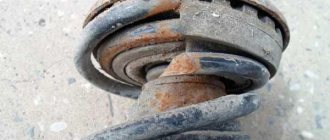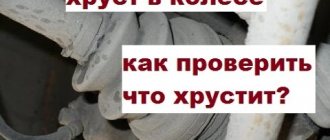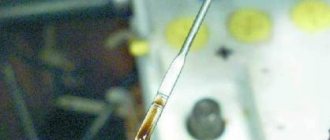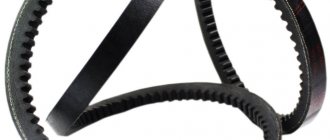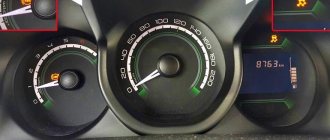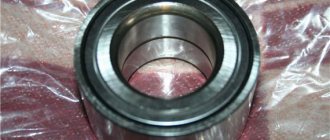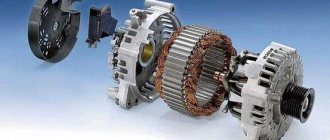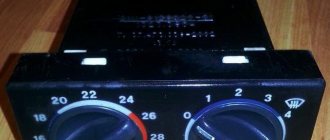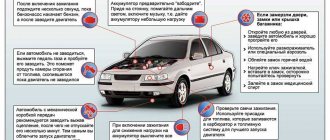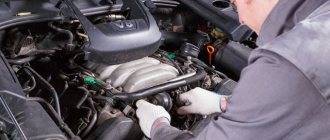The constant velocity joint (CV joint) is an integral component of all front- and all-wheel drive vehicles. It ensures the transmission of torque to the axle shaft and drive wheel.
There are two hinges installed on the axle shafts:
- internal CV joint located on the gearbox side;
- external CV joint located on the wheel side.
The unit consists of 4 parts: a spherical body, an internal race, a separator and balls. Like any machine part, joints gradually wear out and require replacement.
Crunching is a characteristic sign of malfunction
CV joints are fairly reliable units, but they also fail. Problems with them manifest themselves in the form of distinct crunching sounds when performing maneuvers, knocking noises when turning the steering wheel, and vibrations (twitching) of the car when driving over uneven surfaces.
Experienced drivers call this unit more simply – a grenade.
If a crunch is a characteristic sign of a grenade malfunction, then other structural elements can also make knocking noises in the front of the car, so when they appear, you must first perform diagnostics and determine which component is faulty.
Moreover, even if there is complete confidence that something is wrong with the CV joints, you still need to find out which unit is problematic, because the drive design uses 4 such components (2 internal and 2 external, a pair for each left and right drive shafts).
Types of CV joints, their design features
The most common types of CV joints in the design of front-wheel drive passenger cars are ball and tripoid.
The former are often used on the outside, the latter as internal hinges. On some models, ball devices may also be installed exclusively.
The design of these types of CV joints differs, and significantly. The tripoid assembly consists of an outer casing of a certain shape, on which there is a drive shaft end stop (thanks to it, the drive is connected to the gearbox).
The housing contains a tripoid with rollers, mounted via a splined connection on the drive shaft.
Ball CV joints are partially similar in design to conventional bearings - there are two cages between which the balls are located in the separator.
The outer ring of the unit is its body, on which another shaft end is attached (it is installed in the wheel hub). The inner race is mounted on the drive shaft by means of a spline connection.
The transfer of force from the inner race to the outer one in such a hinge is carried out by balls, which are located in special grooves on the working surfaces of the races.
These same grooves allow the balls to move longitudinally, thereby ensuring transmission of rotation when the drive shaft and end switch are positioned at an angle relative to each other.
A tripoid CV joint is structurally simpler, and therefore more reliable, but it is used only as an internal hinge. This is due to its operational characteristics - they allow significant longitudinal movements of the tripoid relative to the body (provides a change in the length of the drive), but at the same time it is limited in the angle of rotation of the limit switch relative to the shaft.
In ball joints, the angle of rotation is much larger, so it is better suited for use on the outside of the drive, but such a unit does not provide significant longitudinal movements.
Due to their more complex design, very harsh operating conditions and location (near the wheel), ball CV joints are more susceptible to wear and malfunction; they are smaller in size than their tripod counterparts.
Both types of CV joints are made with high precision, so there are no backlashes in them. But during the operation of the car, the working surfaces of the hinge gradually wear out, which leads to the appearance of backlashes, which are the main cause of unit failure. The wear situation is aggravated by dirt getting inside the joint.
Signs of malfunction when turning and accelerating
Symptoms of malfunctioning external and internal hinges manifest themselves in different ways.
It is quite simple to determine the wear of the outer CV joint by the characteristic crunch when turning, which appears when you start driving with the wheels fully turned, especially when starting at high engine speeds.
Additionally, vibration may occur on the steering wheel. When the wheels are aligned, the sound disappears. This is all due to the peculiarities of the operation of the hinges - as the angle between the shaft and the limit switch increases, the load on the CV joint increases, and if there are backlashes in it due to wear, then they lead to a crunch in the unit.
Internal hinges do not work at such significant angles as external ones, so they do not always make a crunching sound, which complicates their diagnosis.
Malfunction of CV joints installed near the gearbox often manifests itself in the form of vibrations and knocking in the front suspension when the car moves over uneven surfaces. Moreover, the more unevenness (deep holes, strong bumps), the stronger the knocks.
In some cases, symptoms of a faulty inner joint appear even when driving on a flat and straight stretch of road when accelerating to 100 km/h or above.
Universal diagnostic method
Diagnosis of a malfunction of the internal CV joint
We present to you an algorithm for another, universal option, how to find out which “grenade” is crunchy. You need to act in the following sequence:
- Place the car wheels level.
- Raise one of the front wheels using a jack.
- Put the car on the handbrake and neutral gear.
- Start the engine, depress the clutch, engage first gear and slowly release the clutch, that is, “move off” (as a result, the suspended wheel will begin to rotate).
- Slowly press the brake pedal, creating a natural load on the joint. If one of the internal “grenades” is faulty, then at this time you will hear familiar knocking sounds on the left or right side. If the internal CV joints are in order, then the car will simply start to stall.
- Turn the steering wheel all the way to the left. Slowly press the brake pedal. If the internal “grenade” is faulty, it will continue to knock. If the outer left CV joint is also faulty, then sound will also be added from it.
- Turn the steering wheel all the way to the right. Carry out similar procedures. If a knocking noise occurs when the steering wheel is turned to the right, it means that the right outer joint is faulty.
- Be sure to put the gear in neutral, turn off the engine, and wait until the wheel comes to a complete stop before lowering it to the ground.
We determine which CV joint crunches, the inner or outer one
Several methods are used to diagnose CV joints. The simplest of them is a visual inspection of the anthers and checking the shafts.
The main cause of problems associated with the appearance of crunching is the ingress of dirt into the nodes, which can only occur due to damage to the boot.
If the rubber element is torn, then upon inspection there will be traces of leaking lubricant on it, from which you can understand which of the units got sand and dust.
Also, during inspection, you should try to move the drive shaft in the transverse and longitudinal directions by hand. CV joints are highly precision-manufactured units, and if it feels like they have play, it’s time to take action.
If, during a visual inspection, no leaks in the boot are detected, but symptoms of a joint malfunction appear, several simple methods can be used to identify which of the CV joints is problematic.
Identifying a specific faulty joint
Since a front-wheel drive vehicle has four CV joints, it is important to isolate the problem and determine which one requires replacement or, at a minimum, lubrication. Many people do not know how to do this, although in many cases everything turns out to be not so difficult.
First of all, of course, you should do a visual inspection. If the boot is damaged, then the CV joint definitely requires, at a minimum, dismantling, maintenance, lubrication and replacement of the protective rubber boot, and at maximum, replacement. Damage to the boot will be indirectly indicated by grease splashed on adjacent parts.
Try turning the hinge around the axis by hand. A serviceable CV joint should remain stationary. If there is play, then the hinge definitely needs to be replaced. However, it will be more reliable to determine the presence or absence of play by dismantling the axle shaft with grenades and holding it in a vice.
The CV joint crunches at low temperatures, what to do?
As a rule, at low temperatures, the cause of crunching of CV joints is poor-quality lubricant, which is not able to perform its functions in extreme cold.
Car manufacturers, when supplying their products to Russia, must take into account the operating conditions.
The frozen lubricant binds the internal elements of the grenade and does not get into all the cavities of the assembly, which is why the crunch appears.
At this moment there is no need to turn sharply and pick up speed; after a few kilometers (20-30) the components will warm up and the crunching will disappear by itself.
But the problem is that the internal grenades warm up quickly, but the external ones at very low temperatures may not warm up and the crunch will remain.
There is an opinion (and not without reason) that the problem is not only in the lubrication, but also in the design of the CV joint itself. The fact is that the lubricant put into the product may not be suitable for this design, while on other car models it works well even at temperatures below -200C.
Some car owners are guilty of using polyurethane boots, which can be installed on some brands of cars instead of rubber ones. They say that in the cold they tan and make sounds. This is a controversial opinion that requires verification.
The problem can be solved by replacing the lubricant; some car owners recommend LM47, VERYLUBE, XADO, they performed well at low temperatures. But it’s difficult to give any advice here, the choice on the market is huge and opinions vary.
But, you need to change the lubricant not just by pressing it under the boot, but completely remove the assembly, disassemble it and press the new lubricant as much as possible instead of the old one into hard-to-reach places. It is these places that cause crunching in severe frost, especially for external grenades.
Do-it-yourself replacement or professional help
So, knowing how to check the CV joint and being sure that it is the one that is faulty, the car enthusiast has a question about how to fix the breakdown. It is irrational to repair CV joints; such parts must be replaced. If you have a convenient garage and all the necessary tools, you can carry out the repairs yourself.
If you have doubts about your own abilities, or do not have an experienced mentor or the necessary tools, then it is better to seek help from a car service center. Otherwise, there is a risk of incorrect installation and damaging the new part.
Elimination of crunches and knocks, restoring the operation of CV joints
How to find out which CV joint is crunching - we figured it out, now about the measures that should be taken to fix the problem, since it is undesirable to operate a car with problematic joints.
One of the disadvantages of CV joints is their non-repairability, that is, if the joint crunches, then it is worn out and requires replacement. The only thing that can be done is to “extend the life” of the node and delay its replacement.
Since the main reason for the appearance of crunches is dust and dirt, when they appear, you should immediately inspect all the anthers for damage. If none are found, we determine which CV joint is crunching using one of the above methods.
After identifying the problematic hinge, we try to extend its service life. To do this you need:
- Remove the drive from the car;
- Disassemble the CV joint;
- Thoroughly wash all components with gasoline, solvent or other means (white spirit, etc.);
- Apply new CV joint grease or equivalents (see above) and assemble the hinge;
- Install a new boot;
- Install the rebuilt drive on the car.
At the initial stage of wear, these measures are enough to get rid of the crunches, but they will eventually return (when the wear intensifies) and then the hinge will have to be replaced.
Solution
Having identified a problematic hinge, you need to dismantle it, disassemble it, thoroughly wash it and inspect it. If there are wearouts, damage, or play, the CV joint should be replaced with a new one. There is no point in repairing it. Attempting to sand work surfaces will most likely be a waste of time and effort and will not provide long-term results.
If the part is in order, after washing it should be filled with special lubricant for CV joints and returned to its place. The same should be done with the new hinge. As a rule, for an internal grenade you need about 100... 120 g of lubricant, for an external one - a little less. During assembly, lubricant must also be placed under the boot, and then securely tighten it with clamps on both sides.
Since errors during installation of CV joints can lead to their premature failure, it is better to carry out this procedure for the first time in the presence of a more experienced car enthusiast, who will explain all the intricacies of the process along the way.
When replacing parts that have a symmetrical pair in a machine, you should follow the general rule - change both elements at the same time. This rule should also be applied to CV joints, but with one important clarification: never remove both axle shafts at once to prevent the differential gears from shifting. First, work with one axle shaft and install it in place, only then you can dismantle the second one if necessary.
Cheap hinges, produced under little-known brands, are often made of low-quality metal and are not very carefully assembled; there are also initially defective parts. Such products should be avoided. You should also be careful when choosing where to buy. In the Chinese online store you can purchase the necessary spare parts for transmissions, suspensions and other systems of cars made in China and Europe.
How to recover?
With an average degree of wear, the problem with crunching can be solved by washing the unit and adding new lubricant to which soft plastic shavings have been added (a Champagne cork or a nylon lid for cans will do).
During operation, the CV joint assemblies will easily crush such chips and fill with them the formed traces of wear on the working surfaces, thereby eliminating the backlash. But the effect of such a restoration will be short-lived, and ultimately the hinge will have to be replaced.
In the end, we note that for long-term and trouble-free operation of constant velocity joints, it is enough to only periodically check the condition of the anthers, if a tear is detected, immediately replace them and wash the assembly.
With such measures, the CV joint can fail only with severe natural wear, but this will not happen soon.
A little theory
CV joints (constant velocity joints) perform one single, but very important task, namely the transmission of torque at rotation angles of up to 70 degrees relative to the axis.
CV joints are used only in all-wheel drive and front-wheel drive vehicles to ensure the front wheels turn and rotate under load.
CV joints are divided into:
- Internal
-
transmit torque from the gearbox to the drive shaft. - External
-
transmit torque directly to the wheels.
I will not analyze in detail the structure of CV joints, since the article will turn out to be too long and tedious, and you decided to read it only in order to find out how to carry out a quick and effective diagnosis. Therefore, I will simply advise you to check the CV boots more often, since some manufacturers themselves say that generally CV joints only have to be changed when the boot breaks.
Well, now let's get straight to the point.
